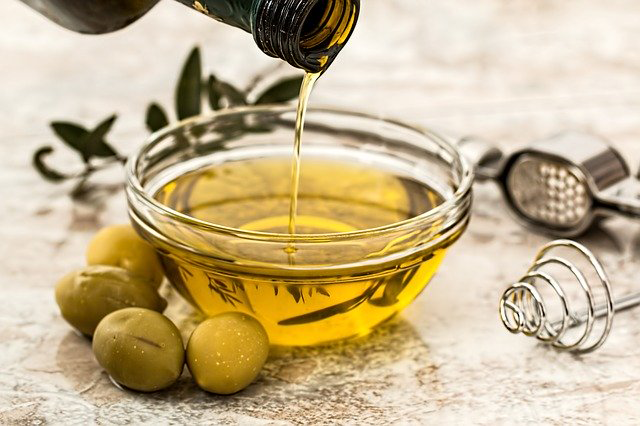
By Mike DuBose with Blake DuBose and Dr. Surb Guram, MD
Olive oil’s health benefits have been touted by many studies, experts, and health organizations, including the Mayo Clinic and the American Heart Association. Research has shown that, when used in place of other fats like butter and margarine, olive oil’s healthy unsaturated fats can help prevent heart disease. The Cleveland Clinic notes that research has shown olive oil to have “beneficial effects on almost every bodily function.” For these reasons, olive oil has gained a reputation as one of the healthiest oils you can use for cooking, baking, and flavoring foods.
However, despite its stellar reputation, there are many misconceptions—and even some fraud—associated with olive oil as well. Some supposed “olive oils” on store shelves contain large amounts of cheaper oils, or may be doctored with beta carotene and chlorophyll to fake the appearance and scent of olive oil. Others are deceptively labeled to make you think you’re getting a high-quality oil when you’re not. In addition, even legitimate olive oils can go stale in a short period of time—much faster than you would think.
So how do you know that you’re getting your money’s worth—and that what you’re buying is real extra virgin olive oil? We’ve done some extensive research on current studies to find out what you need to know about olive oil’s benefits and dangers, as well as some of the most common lies and misperceptions about this popular food.
Why is olive oil good for you? The best quality, pure, extra virgin olive oils contain high levels of anti-inflammatory plant chemicals known as polyphenols. (These chemicals are also found in honey, legumes, blackberries, blueberries, grapes, cherries, peas, plums, broccoli, cabbage, onions, nuts, red wine, dark chocolate, and many herbs and spices.) The American Journal of Clinical Nutrition reports that polyphenols are an abundant source of micronutrients that prevent inflammation, keep arteries healthy, prevent damage to DNA, and reduce the likelihood of certain cancers. There is no set dietary requirement for polyphenols, but the USDA recommends consuming two cups of fruit and two to three cups of vegetables each day, aiming for a rainbow of different colors. Olive oil is another great source. It can be consumed as a cooking oil, salad dressing, food flavoring, or bread dip, or used in place of butter when making baked goods.
Olive oil also contains many other helpful nutrients, including beta carotene and vitamins A, E, D, and K. According to the Cleveland Clinic, olive oil lowers your LDL (“bad”) cholesterol and raises your HDL (“good”) cholesterol. Some studies also indicate that the monounsaturated fats in the oil can help Type 2 diabetics control their insulin and blood sugar levels.
But there can be too much of a good thing: Although olive oil has documented health benefits (and tastes great), it is best used sparingly. Just one tablespoon contains about 120 calories and 14 grams of fat (albeit the “good” type of fat). It may be tempting to dip some bread in a puddle of olive oil sprinkled with herbs, but don’t go overboard—you could be soaking up several hundred calories in a short period of time! Like any other fat, olive oil can cause weight gain if you consume too much, and being overweight is linked to a multitude of health problems. So, enjoy your olive oil in moderation!
Olive oil grades and which is the best: Olive oil was first used in the Mediterranean area around 3,000 B.C. Today, there are more than 1000 varieties of olive oil available, produced by more than 8,000 companies. Olive oil comes in varying grades, and many factors play into classification. The types of olives used, where the olives are grown, how they are pressed, their harvest date, the way different oils are blended together, various ways the oil was handled during shipping, and the bottle used to store the oil all effect its quality.
There are many different classifications of olive oil (including extra virgin, virgin, refined, and others), but extra virgin is the type you should buy to enjoy health benefits (and the best taste). According to a 2015 Wall Street Journal article by Nancy Harmon Jenkins, “The only olive oil worthy of consideration is extra virgin. Anything else, whether labeled pure, light or just plain olive oil, has been heavily refined into a pallid, flavorless substance to which a little extra virgin oil is added for color and flavor.” She recommends, “If that’s all your supermarket offers, opt for one of the other oils on the shelf.” Extra virgin offers a health bonus, too: Janet Bond Brill, PhD, RDN reports in Bottom Line Health that extra virgin olive oils “have up to 10 times higher polyphenol contents than lower-grade oils.”
“Extra virgin” means that the product only contains the oily juice of the olive (from which the water is removed). Jenkins reports that the high-quality extra virgin olive oils may be filtered but not refined, so they are not standardized. Depending on the producer and where the olives came from, extra virgin olive oils can vary greatly in aroma and flavor from each other. The best olive oils are made from olives that have been hand-harvested and milled locally soon after being picked, which means they will be more expensive, but better tasting. Extra virgin olive oils should also be “cold pressed,” processed without the use of heat or chemicals, which could damage the helpful polyphenols.
Seek certifications: Although there is no overall regulatory agency for olive oil, there are some organizations that perform quality checks, and certifications from these groups guarantee a decent product. Look for markings from the following organizations—often, a small orange or yellow circle—when considering a bottle of olive oil (some may be dependent on where the oil is from, such as California or Italy):
- North American Olive Oil Association (NAOOA)
- California Olive Oil Council (COOC)
- International Olive Council (IOC)
- Protected Designation of Origin (PDO)
- Denominazione d’Origine Protteta (DOP)
Where do the best oils come from? Although Italy is probably the most famous olive oil producer, high quality olive oils can come from many places around the world. Italy (especially the Tuscany region), Spain, and Greece all produce some excellent olive oils, and the United States (California and the surrounding area) has recently gained recognition in the field. South American and Australia are becoming well-known for high quality olive oils, too. Each location’s oils boast a unique flavor due to differences in soil content and growing environments.
Beware of fakes! Some studies indicate that more than half of the olive oil sold worldwide is fraudulently labeled, often containing just a small amount of olive oil and consisting mostly of cheaper oils like canola, vegetable, or soybean oil. Such oils lack the heart and other health benefits that consumers expect from real extra virgin olive oil. In fact, in a 2010 University of California at Davis study, 69% of what was being sold as “extra virgin olive oil” failed standards set by the US Department of Agriculture (USDA) and the International Olive Council (IOC)! Also, if there is any suggestion on the bottle that the oil contains Omega-3 vitamins, it is likely contaminated with another oil—olive oil does not naturally contain more than trace amounts of Omega-3s.
Even when dealing with actual olive oil, unscrupulous companies use fraudulent terms for low-quality oils in an attempt to mislead consumers. They may use terms such as “pure,” “light,” or “first pressed” that are either meaningless or outright false. Instead, look for the term “extra virgin” and certifications from legitimate agencies to help choose a good bottle.
Read labels very carefully to ensure that the oil you are considering comes from olives grown and processed in the country it is supposedly a product of—not just bottled there! We recently examined many olive oil brands at the grocery store (and some even in our own pantries), and found plenty that said “Product of Italy” …only for the bottle’s fine print to reveal that the olives were grown and processed in other places. For one of our prized bottles purchased in Italy, the Italian manufacturer was merely packaging and shipping the oils, which actually originated from Turkey! Look for the phrase “Produced and Bottled” to indicate that the oil was truly made where it says it was.
How old is your oil? You want to buy the freshest possible oil to enjoy the best flavor and greatest health benefits. The shorter the amount of time from when the olives are harvested to when they are pressed, the better. Quality producers include both the harvest date (when the olives were picked) and the production date (when the olives were processed into olive oil). Brill recommends looking for bottles with a harvest date of no more than one year ago (you can also use the “Best by” date marked on the bottle as a guideline; this should be no more than 18 months from the date you buy it). Ideally, olive oil should be consumed within 24 months of processing. Once this two-year mark has been reached, the health benefits, taste, and aroma greatly decline!
Choose dark containers: Olive oil is very sensitive to light and heat. Exposure to these elements can cause it to lose freshness and health benefits, so avoid buying oil that is sold in clear containers. Instead, look for dark bottles or cans to provide some protection.
Store it wisely: Locate your olive oil in a cool, dark place (like a cabinet or pantry, instead of a well-lit countertop). Once a bottle is opened, seal it tightly to prevent air from getting inside. Use the bottle within a few months for optimal freshness, flavor, and health benefits.
The bottom line: Understanding what you are buying and how to keep it fresh can go a long way toward reaping the maximum health, flavor, and cooking benefits of extra virgin olive oil. You may need to invest a little time and extra money to find a high-quality product, but the results will be worth it! Buon appetito!
About the Authors: Our corporate and personal purpose is to “create opportunities to improve lives” by sharing our knowledge, research, experiences, successes, and mistakes. You can e-mail us at katie@dubosegroup.com.
Mike DuBose, a University of South Carolina graduate, is the author of The Art of Building a Great Business. He has been in business since 1981 and is the owner of Research Associates, The Evaluation Group, DuBose Fitness Center, and Columbia Conference Center. Visit his nonprofit website www.mikedubose.com for a free copy of his book and additional business, travel, health, and personal published articles.
Blake DuBose graduated from Newberry College’s Schools of Business and Psychology and is president of DuBose Web Group (www.duboseweb.com).
Katie Beck serves as Director of Communications for the DuBose family of companies. She graduated from the USC School of Journalism and Honors College.
Dr. Surb Guram, MD is a board-certified internist and a graduate of the University of South Carolina School of Medicine. He is a partner with the SC Internal Medicine Associates in Irmo, SC and has practiced internal medicine in the Midlands for the past 30 years. See www.scinternalmedicine.comfor more information on Dr. Guram and his practice.
© Copyright 2016 by Mike DuBose—All Rights Reserved. You have permission and we encourage you to forward the full article to friends or colleagues and/or distribute it as part of personal or professional use, providing that the authors are credited. However, no part of this article may be altered or published in any other manner without the written consent of the authors. If you would like written approval to post this information on an appropriate website or to publish this information, please contact Katie Beck at Katie@dubosegroup.com and briefly explain how the article will be used; we will respond promptly. Thank you for honoring our hard work!



